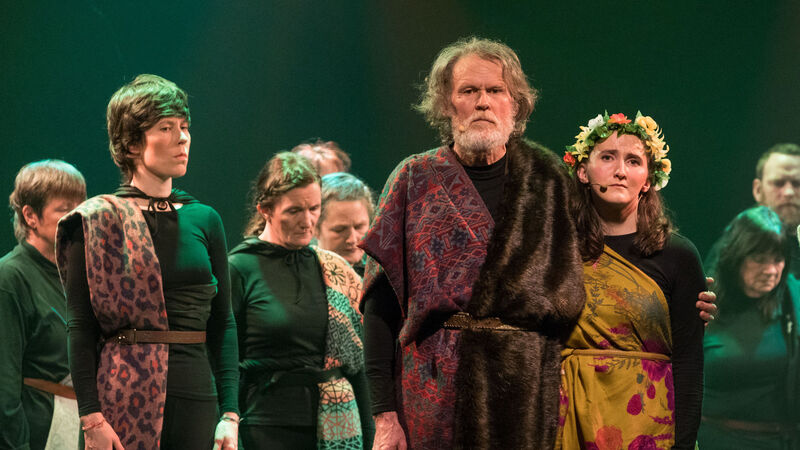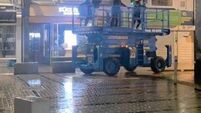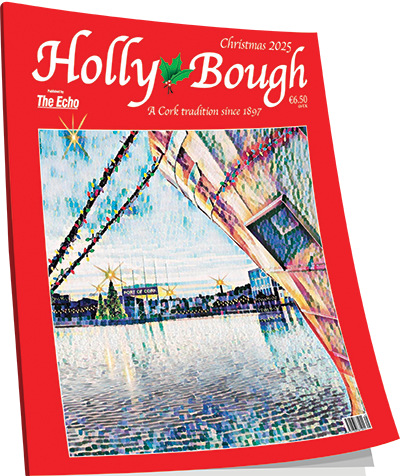Cork's Gaeltacht communities: Rumours of the death of Irish greatly exaggerated

Pádraig Ó Duinnín as Cairbre an Rí and Sarah Ní Ríordáin as Gobnait in a scene from the play 'Gobnait' An Ceoldráma' which took place at An Halla, Béal Átha'n Ghaorthaidh , Co. Cork. - Picture: David Creedon
The Gaeltacht is dying. That’s been the narrative for decades about the communities where Irish is the day-to-day language. The narrative has taken hold to such an extent that the most frequent image to denote the Gaeltacht in the media is a battered and rusty road sign for ‘An Ghaeltacht’ — with RIP scratched across it.
In Cork, Ireland’s largest county, lie two of the smallest Gaeltacht communities: Múscraí, in mid-Cork, stretching from west of Macroom to the county bounds and including the villages of Baile Mhúirne/Baile Mhic Íre, Cúil Aodha, Béál Átha’n Ghaorthaidh, Cill na Martra, and Réidh na nDoirí; and Oileán Cléire/Cape Clear, the island off the West Cork coastal town of Baltimore.
Here, community activists say there are developments that challenge the prevailing narrative.
Irish as a living language faces challenges, not least being the lack of interest from Cork County Council, but there are indications that things are not as bleak as some statistics suggest.
Ruairí Ó Donnabháin is the oifigeach pleanála teanga (language planning officer) for Oileán Cléire and is employed by the local co-operative, Comharchumann Cléire, which is one of a number of lead bodies around the Gaeltacht areas.
His task is to help to revitalise the Irish language.
From Douglas in Cork city, Ruairí is upbeat. “The official population is 124 and it goes up and down, but it’s a very strong community,” he told The Echo.
“The language plan is a great resource and we’re in the third year of implementing it.”
Oileán Cléire is buzzing with activities and festivals during the summer, with a lavender festival, Gaeltacht ‘Pride’ events, as well as sailing weekends, a storytelling festival, and numerous other activities.
“We’re organising events all the time; there’s something happening on Cléire every day,” Ruairí Ó Donnabháin said.
One of the greatest challenges faced by the island is to increase the population and the Comharchumann is restoring four houses with the support of the Croí Cónaithe scheme.
It is hoped that this will entice families with young children to come and live on the island and get their education in the local national school, whose roll book is challenged.
“We hope to have the first two houses ready by September and the other two by Christmas,” Ruairí said.
“That, along with the news that 14 people under the age of 50 have moved on to the island in recent times, is the good news that we want to spread.
“In the context of an island with a population of 124, the addition of 14 new people is a huge thing.”
The vitality of the Irish language is a key part of Oileán Cléire’s future. “It’s really important to us to keep the language alive and to continue to celebrate the history and tradition of the island,” he said.
“We help people who need lessons to learn it, so as to enable them to feel comfortable using it in their daily lives.”
The Múscraí Gaeltacht is not unlike an inland island, surrounded by a sea of English speakers. It’s a community synonymous with Irish traditional music and culture, a reputation that was boosted in the 1960s with the arrival of Mise Éire composer Seán Ó Riada and his family, but in 2025 it faces many challenges.
In Baile Mhúirne/Baile Mhic Íre, for instance, a proposal to build eight social-housing units was approved without a language condition, the condition being that a certain proportion of the people allocated these houses would have to be Irish speakers.
This is the practice in every other local authority with Gaeltacht communities, but there’s no such provision in the County Development Plan for Cork County Council.
Following a recent debate during a meeting of the local authority, it was pledged to revisit this position, which has been roundly condemned by Irish-language organisations nationally.
But despite the inertia of the authorities, Gaeltacht life goes on. According to Seán Ó Cúill, the cathaoirleach (chairman) of Comhaltas Cosanta Gaeltacht Chúil Aodha, green shoots of hope are plentiful.
“Look at all the summer camps that are ongoing,” Seán Ó Cúill said, “People are travelling from near, here in the Gaeltacht, and far, from places such as Knocknagree and Mallow, to come to them and it’s all Irish being spoken.”
Seán also pointed to the numerous festivals hosted in the area, each of which highlights the language in its own way, the likes of Féile na Laoch (Festival of Heroes) or An Fhéile Náisiúnta Drámaíochta (National Irish Language Drama Festival) or Féile Ghobnatan.
These types of events — where Irish is central — must continue to happen, he said.
In Béal Átha’n Ghaorthaidh, there’s no shortage of activities, either, particularly during the winter.
A highlight last year was the Irish-language musical, Gobnait an Ceoldráma, which involved scores of aspiring actors and singers from the area in a production written and produced by Scoil Mhuire principal, Seán Óg Ó Duinnín, along with Alan Kiely and Kevin Connolly.
It sold out several nights in Béal Átha, as well as Cork Opera House, during Seachtain na Gaeilge.
Caroline Ní Nualláin, the bainisteoir (manager) of Comharchumann Forbartha Mhúscraí, was full of praise for the lasting impact participation in the musicals has had for those who were involved.
“Never did I think, when we were first asked to support a new Irish-language musical, based on historical events in the area, that it would be so successful,” she said.
“The productions of Tuairín Dubh and Gobnait have inspired everyone who has seen them.
“And many who have only a cúpla focal and never set foot in a theatre were delighted that it was also so accessible to them. Let’s hope we see a lot more of them.”
The one blot on the landscape in Béal Átha’n Ghaorthaidh is the lack of activity around its historic Irish summer college, Coláiste na Mumhan.
No summer courses have been run there since 2023 and before that there had been no courses since 2019.
At a time when Irish summer colleges have lengthy waiting lists, this is a cause of huge frustration to the local community, as it deprives young people of employment opportunities and businesses of income.
“More important than that, and that is important, is the way it impacts us as a Gaeltacht community,” said Tadhg Ó Duinnín, of the local Coiste Forbartha.
“Coláiste na Mumhan is an important part of our Gaeltacht identity. When it’s not functioning, it’s draining that away.”
The Coiste Forbartha has challenged the trustees of the college to resign and hand over the running to it, so that courses can be organised there next year.
Cill na Martra hosted the annual All-Ireland Comórtas Peile na Gaeltachta last year and, according to Gearóid Ó hÉalaithe, the chairman of the GAA club, it was an enormous boost for the language.
“We are a Gaeltacht community, but there are some who are not as involved in the language as others, but the Comórtas had a really positive impact,” he said.
“It transformed the mood of the people towards the language — and that’s still being felt.”
Gearóid said that the success of the local Comhaltas Ceoltóirí Éireann branch in getting young and old involved in competitions for singing and Irish-language conversation, and other Fleadh Cheoil events, has also been key.
“Craobh Lachtaín Naofa are having a hugely positive impact on the language’s vitality in the area,” he said.
While he praised Údarás na Gaeltacht for its work in Múscraí and its support of initiatives in Cill na Martra, he said that it would be great if the Gaeltacht development agency were to have some official presence, a factory or other office in the village or in nearby Réidh na nDoirí, which is in the same parish.
“It would really boost the idea people have, that this is a Gaeltacht, if we could see it up on a sign outside an Údarás facility,” he said.
The language-planning initiative got under way in 2018, but was interrupted by covid. It will probably take another seven-year cycle before progress can be measured.
According to the 2022 census, the population of the Cork Gaeltacht areas has increased since 2011, when it was 3,895, to 4,110 in 2022. The Irish-speaking proportion of that population has fallen, however, in the same period, from 2,951 in 2011 to 2,942 in 2022.
Statistics tell a black-and-white version of the story, but the indication from the Cork Gaeltacht communities of Múscraí and Cléire is that there are green shoots of hope.







 App?
App?





